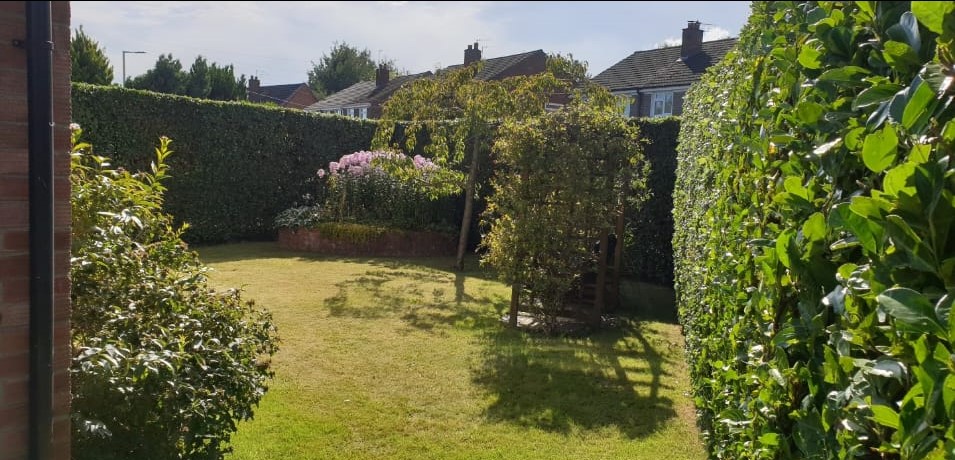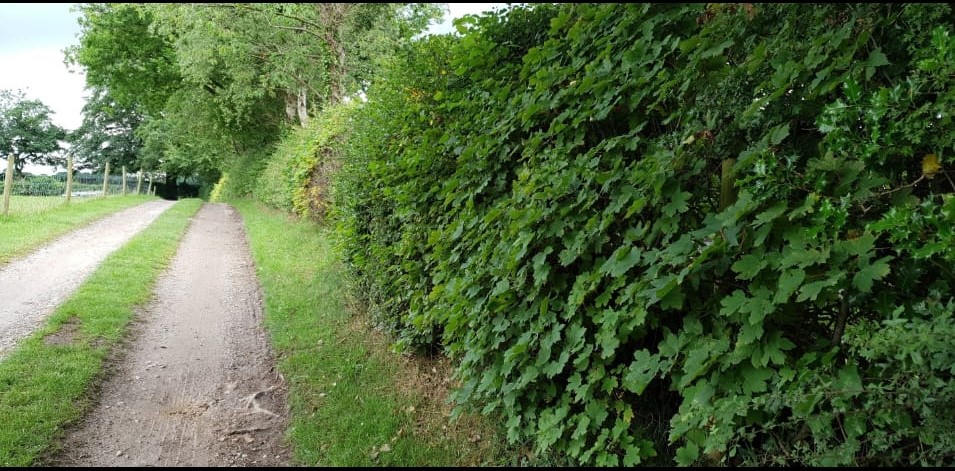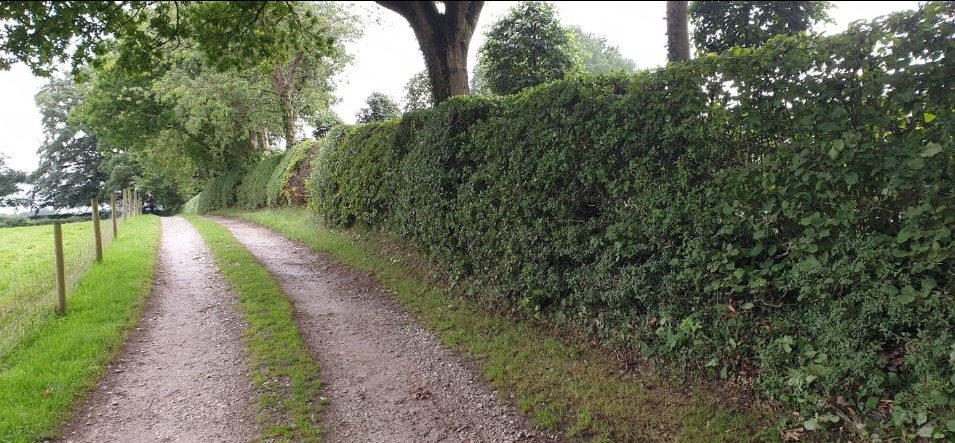Trees and Hedges
The Importance of Trees and Hedges in Your Garden
Planting trees and hedges in your garden can make it look beautiful, provide shade and privacy, and contribute to the local environment. Whether you are looking to add mature trees to create an immediate impact or plant baby trees and hedges to watch them grow over time, there are many factors to consider. Let us walk you through the different types of trees and hedges suitable for various garden types, the benefits of incorporating them into your landscape, and the best practices for planting and maintaining them.
Benefits of Having Trees in Your Garden
Trees offer numerous benefits beyond looking lovely. Here’s why you should consider planting them in your garden, whether you’re in Cheshire towns like Northwich, Nantwich, or in Trafford areas such as Partington or Timperley.
Environmental Impact:
Trees absorb carbon dioxide and release oxygen, helping to improve air quality. They also provide habitat for birds and other wildlife.
Shade and Cooling:
Trees provide natural shade, which can reduce the temperature in your garden and even lower your home’s energy costs by blocking direct sunlight.


Increased Property Value:
A well-landscaped garden with mature trees can increase the value of your property by up to 20%, especially in desirable locations like Alderley Edge, Cheadle Hulme, and Hale.
Privacy and Noise Reduction:
Trees can act as natural screens, offering privacy from neighbours and reducing noise pollution, particularly useful in busy areas like Stockport, Sale, and Altrincham.
Types of Trees to Plant in Different Gardens
When selecting trees for your garden in Cheshire or Trafford, consider the size of the space, the climate, and the overall design you wish to achieve. Here are some popular tree options for different garden types.
- Japanese Maple (Acer palmatum): Known for its vibrant foliage, Japanese Maple is ideal for small gardens in towns like Hale, Sale, and Altrincham. It provides year-round interest and does not grow too large, making it perfect for compact spaces.
- Crape Myrtle (Lagerstroemia): This small, ornamental tree offers beautiful summer blooms and colourful autumn foliage. It thrives in sunny spots and requires minimal maintenance, ideal for gardens in Wilmslow and Knutsford.
- Silver Birch (Betula pendula): Silver Birch is a versatile tree that adds elegance to medium-sized gardens in places like Macclesfield, Alderley Edge, and Bowdon. Its delicate foliage and peeling bark are visually appealing throughout the year.
- Magnolia (Magnolia grandiflora): Magnolias are known for their large, fragrant flowers. They can grow up to 20-30 feet tall, making them a great focal point in medium-sized gardens in towns such as Poynton, Congleton, and Lymm.
- Oak (Quercus robur): Oaks are majestic trees that can live for hundreds of years. They provide ample shade and are perfect for large gardens in areas like Prestbury, Hale Barns, and Didsbury, where they have plenty of space to grow.
- London Plane (Platanus × acerifolia): A popular choice for urban areas like Stretford, Sale Moor, and Urmston, the London Plane is resilient and can tolerate pollution. It grows large and provides excellent shade.
Where to Plant Trees in Your Garden
Choosing the right location for planting trees is crucial for their growth and your garden’s overall desi
- Sunlight: Most trees require full sun to thrive, so choose a location that receives at least six hours of direct sunlight per day, whether you’re in Knutsford, Marple, or Timperley.
- Soil Type: Ensure the soil in the chosen location is suitable for the tree species you are planting. Some trees prefer well-drained soil, while others can tolerate clay or sandy soil, as found in areas like Bollington and Runcorn.
- Proximity to Structures: Plant trees at least 15-20 feet away from buildings, fences, and other structures to avoid root damage and provide enough space for growth, especially in towns like Urmston and Wilmslow where space may be more limited.
- Wind Protection: In windy areas like Winsford or Chester, plant trees close to a hedge or other windbreaks to protect them from strong gusts.
How to Maintain Trees
Proper maintenance is essential for the health and longevity of your trees. Here’s how to keep them thriving, whether you’re in Hale, Sale, or Macclesfield.
- Watering: Newly planted trees need regular watering until they establish their roots. Mature trees generally require watering during dry spells.
- Mulching: Apply mulch around the base of the tree to retain moisture, regulate soil temperature, and suppress weeds.
- Pruning: Pruning helps maintain the tree’s shape, remove dead or diseased branches, and encourage healthy growth. The best time to prune most trees is in late winter or early spring before new growth begins, whether you’re in Congleton or Altrincham.
Costs of Buying Established Trees vs. Baby Trees
The cost of trees varies depending on their size, species, and age:
- Baby Trees (Saplings): These are generally cheaper, costing between £10 and £50. However, they require more time to grow and establish in your garden, whether in Lymm or Alderley Edge.
- Established Trees: These trees, which are usually 5-10 years old, can cost anywhere from £100 to £500 or more, depending on the species and size. They provide an immediate impact but require careful handling during planting.
Best Times of Year to Prune Trees
Pruning is a vital part of tree maintenance. The best time to prune trees depends on the species and your location, be it in Cheshire towns like Sandbach or Trafford towns like Stretford:
- Late Winter to Early Spring: Most deciduous trees should be pruned during this time when they are still dormant. This minimizes stress and encourages robust spring growth.
- Summer: Pruning in summer is ideal for controlling growth and removing dead or damaged branches. However, avoid heavy pruning during this period as it can stress the tree.
- Autumn: It’s generally best to avoid pruning in autumn, as this can stimulate new growth that might not survive the winter, particularly in colder areas like Marple and Bollington.
Different Types of Hedges for Your Garden
Hedges are a fantastic way to define boundaries, provide privacy, and add structure to your garden, whether you’re in Wilmslow, Cheadle, or Bowdon.
- Evergreen Hedges
- Boxwood (Buxus): A classic choice for formal gardens, boxwood hedges are dense, slow-growing, and easy to shape, perfect for areas like Hale and Alderley Edge.
- Yew (Taxus baccata): Yew is another traditional hedge plant that is hardy, evergreen, and long-lasting, making it suitable for gardens in places like Poynton and Prestbury.
- Deciduous Hedges
- Beech (Fagus sylvatica): Beech hedges retain their copper-colored leaves throughout winter, providing year-round interest, ideal for towns like Macclesfield and Knutsford.
- Hornbeam (Carpinus betulus): Similar to beech, hornbeam is robust and retains its leaves in winter, making it ideal for hedging in locations like Didsbury and Sale.
- Flowering Hedges
- Lavender (Lavandula): Lavender hedges are not only beautiful but also fragrant. They attract pollinators and add a Mediterranean feel to your garden, especially in areas like Congleton and Lymm.
- Hawthorn (Crataegus monogyna): Hawthorn is a native, thorny hedge plant that produces white flowers in spring and red berries in autumn, providing food for birds, perfect for rural areas like Sandbach and Bollington.
Why Include Hedges in Your Garden?
Hedges offer several benefits, making them a valuable addition to any garden, whether you’re in Hale Barns, Northwich, or Timperley.
- Privacy and Security: Hedges can act as natural fences, providing privacy and deterring intruders.
- Windbreak: They help protect your garden from strong winds, reducing the risk of damage to other plants and structures, particularly useful in exposed areas like Winsford and Runcorn.
- Wildlife Habitat: Hedges provide shelter and food for birds, insects, and other wildlife, promoting biodiversity in your garden, whether you’re in Wilmslow or Stretford.
- Aesthetic Appeal: Hedges add structure and greenery to your garden, enhancing its overall appearance.
How to Create a Hedge
Creating a hedge involves careful planning and planting. Here’s a step-by-step guide for homeowners in Cheshire and Trafford towns:
- Choose the Right Plants: Select hedge plants that suit your garden’s conditions (soil, light, space) and desired height, whether you’re in Altrincham or Sale.
- Prepare the Soil: Dig a trench where the hedge will be planted, enriching the soil with compost or well-rotted manure.
- Planting: Space the plants according to their mature size (usually 12-24 inches apart). Ensure the roots are well-covered with soil and water them thoroughly.
- Mulching: Apply mulch around the base of the plants to retain moisture and suppress weeds, a step that’s particularly crucial in dry areas like Knutsford or Prestbury.
- Regular Pruning: Trim your hedge regularly to maintain its shape and encourage dense growth. The first couple of years are crucial for establishing the hedge.
Costs of Creating a Hedge
The cost of creating a hedge varies depending on the plant species and the length of the hedge.
- Boxwood Hedge: Boxwood can be expensive, ranging from £5 to £15 per plant. For a 10-meter hedge, costs could range from £500 to £1,500, especially in high-demand areas like Hale and Alderley Edge.
- Beech Hedge: Beech plants are more affordable, costing around £1 to £5 per plant. A similar 10-meter hedge would cost between £100 and £500 in towns like Sale and Wilmslow.
How to Maintain a Hedge
Regular maintenance is essential for keeping your hedge healthy and attractive.
- Watering: Newly planted hedges need regular watering, especially during dry spells. Established hedges generally need less frequent watering.
- Pruning: Trim your hedge at least once a year to maintain its shape and encourage thick growth. The best times to prune are late winter or early spring, and again in late summer if necessary.
- Feeding: Fertilise your hedge in spring with a balanced fertilizer to promote healthy growth, particularly in poorer soils found in areas like Sandbach and Bollington.
Best Times of Year to Prune Hedges
Pruning is crucial for maintaining the shape and health of your hedge. Here’s when to do it.
- Evergreen Hedges: Prune in late spring or early summer to encourage new growth and maintain shape.
- Deciduous Hedges: Prune in late winter before new growth starts. A second trim in late summer can help maintain the hedge’s shape.
- Flowering Hedges: Prune immediately after flowering to avoid cutting off next year’s blooms.
Why Use Professionals Like Master Landscapes for Planting Trees and Hedges?
Planting and maintaining trees and hedges can be complex tasks that require knowledge and experience. Here’s why you should consider hiring professionals like Master Landscapes.
Expertise
Professional landscapers have the expertise to choose the right trees and hedges for your garden, ensuring they thrive in your specific conditions, whether in Cheshire towns like Wilmslow or Trafford towns like Sale.
Quality Assurance
Master Landscapes guarantees high-quality plants and professional installation, giving you peace of mind that your garden will look beautiful and flourish.
Time-Saving
Planting and maintaining trees and hedges can be time-consuming. Hiring professionals allows you to enjoy the results without the hard work, a valuable service in bustling areas like Hale Barns and Altrincham.
Comprehensive Service
From soil preparation to planting, pruning, and ongoing maintenance, Master Landscapes provides a full range of services to keep your garden in top shape, whether you’re in Knutsford or Timperley.
Craft Natural Beauty with Precision
Transform Your Outdoor Spaces into Lasting Masterpieces
Enhance Your Garden with Trees and Hedges
Trees and hedges are essential elements of a well-designed garden, offering numerous benefits, from enhancing the aesthetic appeal to providing privacy and supporting wildlife.
Whether you are planting a majestic oak tree or creating a neat boxwood hedge, the key to success lies in careful planning, proper planting, and regular maintenance. For those looking to transform their garden with professional help, Master Landscapes offers expert services to ensure your trees and hedges thrive for years to come.

By using this guide and considering the benefits of professional landscaping, you can create a garden that not only looks stunning but also adds value to your property and contributes to the local environment.

